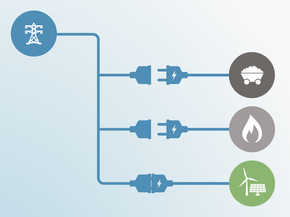Assumptions
Historical emissions
Historical emissions data excl. the LULUCF sector for all GHGs was obtained from the PRIMAP-hist national historical emissions time series and covers the period from 1990 to 2023 (Gütschow et al., 2024). This data is broken down by gas and sector: energy, industrial process, agriculture, and waste. Historical emissions data for the LULUCF sector are calculated based on the Chinese inventory submitted to the UNFCCC for the years 1994, 2005, 2010, 2012, 2014, 2018, 2020, and 2021, including three Biennial Update Reports (BUR) and the latest Biennial Transparency Report (BTR).
As of June 2025, the CAT uses 100-year Global Warming Potentials (GWPs) from the IPCC Fifth Assessment Report (AR5).
We estimated China‘s energy-related CO2 emission in 2024 based on growth rates on fossil fuel consumptions reported by the National Bureau of Statistics of China (NBS of China, 2025)and the total primary energy demand (TPED) from World Energy Outlook (WEO) (IEA, 2024) Stated Policies Scenario (STEPS) and China Energy Transformation Outlook (CETO) (CET, 2025) Baseline Carbon Neutrality Scenario (BCNS).
NDC and other targets
For China’s 2030 NDC targets, we quantify the peaking target, the non-fossil target, renewable energy capacity target (not quantified in this assessment as it has already been achieved), and the carbon intensity target separately. For the quantification of all targets, we also incorporate achievement of the demand-side policies in China’s current policies pathway (CPP).
The elements of China’s targets that we quantify apply to CO2 only (excl. LULUCF), given the scope of the targets. To calculate total GHG emissions (excl. LULUCF), we add non-CO2 emissions based on our current policies projections as described below.
Peaking Target:
Since the NDC contains the target of peaking CO2 emissions before 2030, the implications for what an “NDC scenario” constitutes can be interpreted in a variety of ways—for instance, the least ambitious way would be to assume emissions simply peak by 2030 while a more ambitious interpretation would be to assume that this peaking happens earlier at an arbitrary date. According to our current policy projections, China’s emissions are due to peak around 2025 in both scenarios but either roughly plateau (CPP max) or drop (CPP min). The quantification of the peaking target range is equivalent to the emissions level in our CPP in 2030.
Non-Fossil Target:
China’s NDC non-fossil target has been increased to 25% in 2030 in its updated NDC while China’s 14th FYP includes the now intermediary target of 20% by 2025. In our CPP projections, China is projected to overachieve these targets comfortably.
To calculate energy-related CO2 emissions based on the 2030 target, we:
- Recalculate the total primary energy demand (TPED) from CPPs scenarios based on WEO (IEA, 2024) STEPS and CETO (CET, 2025) BCNS
- Technology shares for non-fossil sources are decreased to achieve the 25% share target (no more, no less), while coal and gas are assumed to replace the gap from decreased non-fossil sources
- Adjust individual non-fossil energy sources equally based on their relative share of non-fossil energy demand in the CPPs
Renewable Capacity Target:
The NDC includes a target of 1,200 GW of wind and solar installed by 2030. As China has already achieved the target in 2024, it is not quantified in this assessment.
Carbon Intensity Targets:
For the calculation of the intensity targets for 2020 and 2030, we use historical emissions data from China’s most recent inventory submission to the UNFCCC and historical GDP data from World Bank database. GDP projections until 2029 are mainly based on World Bank and International Monetary Fund (IMF) database and supplemented with near-term forecasts from a mix of domestic and international sources (thus establishing an optimistic and pessimistic range for growth). We also integrate the underlying GDP forecast from WEO STEPS 2024 as part of the range (IEA, 2024). We assume that the carbon intensity target applies to all CO2 emissions excluding LULUCF. The emissions quantification for carbon intensity targets changes annually, due to updated forecasts in China’s GDP trajectory.
| Energy-related NDC targets | Overview of Key Assumptions | |
|---|---|---|
| Non-Fossil Target: |
• Share of non-fossil energy in TPED reaches 25% in 2030 but does not exceed the benchmark. • Non-fossil demand to reach this target depends on all non-fossil technologies equally. The weight of individual non-fossil energy technologies within non-fossil energy share are assumed to be equivalent as the CPP, but the non-fossil share of TPED differs. I.e. If nuclear makes up 10% of non-fossil energy in the CPP, it will also make up 10% of total non-fossil energy share (revised to 25% in the target scenario). • Non-fossil energy target is assumed to exclude traditional biomass given it emits emissions when combusted and makes up minimal demand in the Chinese energy system. • Since the NDC target is less ambitious than the CPP, all demand for non-fossil energy will be smaller in the target scenario. • Differences in the share of non-fossil energy in the target scenario and CPP is assumed to be displaced or replaced with coal and gas. |
|
| Peaking Target: |
• No specific year is assumed to peak “before 2030” given the vague nature of the target. Thus, we interpret this target as peaking before 2030 and staying at the high level until 2030. • According to our CPP projections, carbon dioxide peaks before 2025. |
|
| Renewable Capacity Target: | Not quantified in this assessment | |
A note on the global aggregation:
China’s rating is based on the two NDC emissions targets which are estimated to have the lowest emission levels: the lower end of the carbon intensity target in 2030 and the upper end of the peaking target (which is the CPP max). We employ this method as we try to capture the likely range of China’s emissions levels when achieving their NDC, but there is uncertainty on absolute emission levels as China has several targets: China’s peaking target is guaranteed to be achieved by definition, but which of China’s remaining NDC targets is achieved (or if they all are) is uncertain.
We exclude the most pessimistic interpretations—target with the highest expected emissions—as we would be assuming they emit more than the CPP analysis shows. We also do not take only the most optimistic interpretation—lower bound of China’s carbon intensity target— as this is not constrained target (fluctuating year to year depending on economic forecasts). If we only took one target, we would then be assuming China’s other quantitative targets are completely null. The emission levels of all of China’s targets are dependent on future developments (e.g., growth in energy consumption, GDP). We thus take a median approach to capture the middle range (median) of the two most stringent targets to be conservative: the minimum of the carbon intensity target and the maximum of the next most ambitious target, the peaking target.
Current policy projections
For our current policy projections (CPP), we establish an optimistic (CPP min) and a conservative (CPP max) range based on different scenarios projecting the development of China’s energy sector based on policies and developments.
We calculate China’s energy-related CO2 emissions in 2025 based on our 2024 estimate, assuming constant emissions from 2024 to 2025 at the optimistic end. At the conservative end, we assume fossil fuel consumption changes at the same rate from 2024 to 2025 as observed from 2023 to 2024, reflecting a modest increase of 1.5%. At both ends of the range, given the limited time remaining, China is expected to miss the short-term carbon intensity reduction targets set out in its 14th FYP (Xinhua News Agency, 2021):
- Reduce CO2 intensity of economy by 18% from 2021 to 2025
- Reduce energy intensity (fossil fuel only) by 13.5% from 2021 to 2025
Emissions for 2030 and 2035 are calculated based on projections from WEO 2024 (for CPP min) and CETO 2024 (for CPP max), with emissions for the intervening years determined through interpolation.
For the CPP min scenario, we start with the Stated Policies Scenario (STEPS) in IEA WEO 2024—which for China we take as a basis for the current policies scenario as stated policies are highly certain to be achieved in the country— and calculate TPED based on the Chinese methodology of applying the average efficiency of coal-fired power plants to calculate TPED from non-fossil sources (renewables and nuclear) (IEA, 2022b). We start with an efficiency of 305.5 grams coal equivalent (gce) per kWh (around 8.9 MJ/kWh for Chinese coal-fired power plants), based on NDRC (2021), which improves over time to 300 gce/kWh in 2025 and 295 gce/kWh in 2030 based on a conservative scenario from IEA (2021b). This is deemed as an optimistic end of the CPP as it is an ambitious interpretation of current policies and achieves China’s NDC targets. Given that China’s NDC targets are now subsumed under domestic policies, and that China’s current policy developments are highly likely to overachieve its targets, we employ this as a minimum bound.
The scenario assumes that China meets a range of policy targets including:
- 20% non-fossil share of energy mix by 2025 and 25% non-fossil share of energy mix by 2030 (Xinhua News Agency, 2021)
- 50% renewable energy capacity by 2025 (SASAC, 2021)
- 39% non-fossil share and 33% RE share (3300 TWh) in electricity generation for 2025 (NDRC and NEA, 2022)
- Doubling wind and solar generation from 2021 to 2025 (L. Wang, 2022)
- Over 50% of incremental electricity consumption is met by renewables from 2021-2025
This scenario describes an optimistic projection of China’s energy system, now freed from the national shift from dual-energy to dual-carbon controls (no longer limiting energy demand growth in guidance to policymakers and developers). This scenario shows a growing energy demand off the back of an accelerated power sector transformation: energy demand is met by an exponential rise in renewable (wind and solar) development and integration. Renewables can both meet the rise of demand and displace fossil fuels, namely coal consumption.
For the CPP max scenario, we take the Baseline Carbon Neutrality Scenario (BCNS) in CETO 2024 (CETO) as the starting point. The BCNS was developed under the assumption that, with significant efforts, China will achieve its medium- and long-term development goals, including peaking carbon emissions by 2030 and reaching carbon neutrality by 2060. However, the CETO 2024 BCNS projects a future in which TPED is too low to represent a conservative projection—7% below current levels by 2030 and 10% lower by 2035. To address this, we adjust the TPED in the CETO 2024 BCNS to align with the levels in our CPP min scenario based on WEO 2024, filling the gap with increased fossil fuel consumption.
The scenario assumes that China meets the same range of policy targets as in CPP min. However, from a conservative perspective, it is possible that China’s emissions will plateau at a high level before beginning a sharp decline. As China’s 2035 NDC is not expected until COP30, we adopt a cautious approach at this stage by holding energy-related CO2 emissions in the CPP max scenario constant at the 2025 level until 2028, implying a three-year delay in emission reductions.
In both scenarios, supply-side targets such as the production capacity of fossil fuels and installed capacity targets from the 14th FYP on energy are not considered binding as these policies will likely result in excess capacity with uncertain outcomes for emissions.
After integrating the aforementioned policies into the energy sector results, we calculate energy sector emissions using IEA WEO 2024 STEPS emission factors for fossil fuels in both scenarios and account for developments in CCUS after 2030.
Industrial-process emissions:
We project industrial-process CO2 emissions by applying growth rates from cement production volume based on the IEA WEO 2024 STEPS scenario to our latest 2023 value estimates. CO2 emissions from industry are now revised to have peaked in 2023, plateauing until 2025—several years earlier than the target outlined in China’s building materials peaking plan (MIIT of China, NDRC, MEE, et al., 2022).
Other non-CO2 emissions:
For non-CO2 emissions from energy, fugitive emissions, agriculture, industrial processes, and waste, we apply sector-specific growth rates for non-CO2 emissions from (Lin et al., 2019) the latest 2023 historical data from PRIMAP version 2.6.
This reference scenario accounts for policies implemented since 2015 and assumes no additional non-CO2 mitigation measures will be adopted before 2050, except for efforts to meet Montreal Protocol targets for phasing out HFCs from HCFC-22 production. The source data published in 2019 may be outdated for projecting emissions beyond 2025. However, more recent projections with comprehensive and accessible data are not available, and China has yet to actively pursue quantified targets for reducing non-CO2 emissions, particularly methane. We expect to update our non-CO2 emissions projections in the next assessment. President Xi Jinping has pledged that China’s 2035 NDC will be made public before COP30, and that it will be economy-wide and cover all greenhouse gases.
We additionally quantify the impacts of the Kigali Amendment on HFCs following the staged phaseout schedule eventually leading to an 80% reduction from baseline levels by 2045.
Mid-Century Long-Term Low Greenhouse Gas Emission Development Strategy
The officially submitted LTS appears to confirm the commitment covers only carbon dioxide emissions. Due to the 2060 timeframe extending past our scope of analysis, as well as insufficient details in intermediary targets to reach the carbon neutrality target, we take a simplified linear approach for China’s pathway to carbon neutrality.
The government is pursuing expansion of China’s carbon sinks in the LULUCF sector. While specific modelling details of these sinks are not provided, the updated NDC commits to increasing forest stock volume by 6 billion cubic meters from the 2005 level (Government of China, 2022). We regress the historical LULUCF sinks and forest stock volumes to predict the LULUCF sinks up to 2030, assuming a linear increase in forest stock volume from 2018 (the latest available data) to 2030. From 2030 to 2060, we assume the LULUCF sinks will remain constant at approximately -1,421 Mt CO2e, pending new policies beyond 2030.
Emissions until 2030 are established through our current policy projections. For CO2 (incl. LULUCF), we assume a linear decarbonisation to zero in 2060 from 2030 levels, CO2 (excl. LULUCF) is thus calculated based on the assumed constant LULUCF sinks. For non- CO2, we assume a more conservative phaseout path to zero in 2080 from 2030 levels. China’s resulting emissions in 2060 (excl. LULUCF) is then assumed to be the addition of CO2 (excl. LULUCF) and leftover non- CO2 GHGs, totalled 2,534 Mt CO2e. The pathway for all GHG emissions from 2030 to the emissions in 2060 is linearly interpolated.
COVID-19 impact
As we now use baseline data that already captures impacts from COVID-19, we apply no further methods to estimate COVID-19 related changes in greenhouse gas emissions for China until 2030.
Global Warming Potentials
The CAT uses Global Warming Potential (GWP) values from the IPCC's Fifth Assessment Report (AR5) for all its figures and time series. Assessments completed before June 2025 used GWP values from the IPCC's Forth Assessment Report (AR4). Assessments completed before December 2018 (COP24) used GWP values from the Second Assessment Report (SAR).
Further analysis
Latest publications
Stay informed
Subscribe to our newsletter






